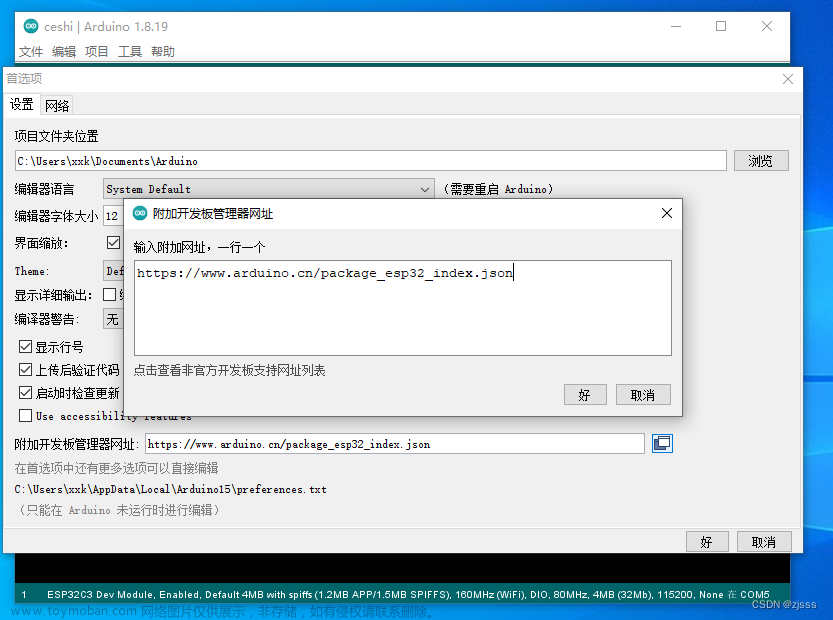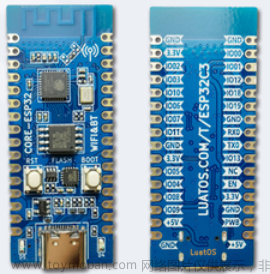合宙ESP32-C3+蓝牙调试器通过BLE发送接收数据教程
一、问题提出
在平衡小车制作过程中,需要对KP/KD/KSP/KSI等PID系数进行调试,而平衡小车无法通过USB等进行有线调试,而ESP32-C3自带蓝牙+WIFI,使用WIFI比较吃算力,故选择通过蓝牙进行调参,同时能够将Angle/Encoder/PWM等数据回传至手机端进行查看。
二、合宙ESP32-C3自带蓝牙分析
前期通过查找资料,发现合宙ESP32-C3自带蓝牙不是经典蓝牙,无法使用BluetoothSerial.h进行编程,只能通过低功耗BLE使用蓝牙。
下面为需要用到的库,PIO环境自带,无需下载。
#include <BLEDevice.h>
#include <BLEServer.h>
#include <BLEUtils.h>
#include <BLE2902.h>
具体原理,没有理解明白,不在赘述。
三、蓝牙调试器分析
蓝牙调试器有3种模式,分别为对话模式、专业调试、按钮控制
需要特别注意的是其通信设置,也就是通信协议。

数据包结构为
| 包头 | 数据 | 校验和 | 包尾 |
|---|---|---|---|
| 1字节 | bool为1字节 | 1字节 | 1字节 |
| 0xA5 | 0x5A |
四、代码框架
/*********************头文件*********************/
#include <Arduino.h>
#include <BLEDevice.h>
#include <BLEServer.h>
#include <BLEUtils.h>
#include <BLE2902.h>
/************************************************/
/********************基本设置********************/
/**/ hw_timer_t *timer=NULL;
/**/ void BClock_Init(int duty_ms);
/**/ static void IRAM_ATTR Timer0_CallBack(void); //以上为定时器
/**/ void Short2Byte(short i,uint8_t *byte);
/**/ void Int2Byte(int i,uint8_t *byte);
/**/ void Float2Byte(float f,uint8_t *byte); //以上为数据类型转BYTE
/************************************************/
#define Step1_BlueTooth 1
/*********************蓝牙BLE********************/
/**/#if Step1_BlueTooth
/**/ BLEServer *pServer = NULL;
/**/ BLECharacteristic * pTxCharacteristic;
/**/ bool deviceConnected = false;
/**/ bool oldDeviceConnected = false;
/**/ uint8_t txValue = 0;
/**/ #define SERVICE_UUID "6E400001-B5A3-F393-E0A9-E50E24DCCA9E" // UART service UUID
/**/ #define CHARACTERISTIC_UUID_RX "6E400002-B5A3-F393-E0A9-E50E24DCCA9E"
/**/ #define CHARACTERISTIC_UUID_TX "6E400003-B5A3-F393-E0A9-E50E24DCCA9E"
/**/ class MyServerCallbacks: public BLEServerCallbacks
/**/ {
/**/ void onConnect(BLEServer* pServer)
/**/ {
/**/ deviceConnected = true;
/**/ };
/**/
/**/ void onDisconnect(BLEServer* pServer)
/**/ {
/**/ deviceConnected = false;
/**/ }
/**/ };
/**/ void getBlueData(uint8_t *Value);
/**/ uint8_t modes[8];
/**/ class MyCallbacks: public BLECharacteristicCallbacks
/**/ {
/**/ void onWrite(BLECharacteristic *pCharacteristic)
/**/ {
/**/ std::string rxValue = pCharacteristic->getValue();
/**/ if (rxValue.length() > 0)
/**/ {
/**/ for (int i = 0; i < rxValue.length(); i++)
/**/ {
/**/ modes[i]=rxValue[i];
/**/ }
/**/ getBlueData(modes);
/**/ }
/**/ }
/**/ };
/**/ void BLEinit()
/**/ {
/**/ BLEDevice::init("BalanceCar");
/**/ pServer = BLEDevice::createServer();
/**/ pServer->setCallbacks(new MyServerCallbacks());
/**/ BLEService *pService = pServer->createService(SERVICE_UUID);
/**/ pTxCharacteristic = pService->createCharacteristic(CHARACTERISTIC_UUID_TX,BLECharacteristic::PROPERTY_NOTIFY);
/**/ pTxCharacteristic->addDescriptor(new BLE2902());
/**/ BLECharacteristic * pRxCharacteristic = pService->createCharacteristic(CHARACTERISTIC_UUID_RX,BLECharacteristic::PROPERTY_WRITE);
/**/ pRxCharacteristic->setCallbacks(new MyCallbacks());
/**/ pService->start();
/**/ pServer->getAdvertising()->start();
/**/ Serial.println("BLE is OK.");
/**/ }
/**/#endif
/************************************************/
void setup()
{
Serial.begin(115200);
#if Step1_BlueTooth
BLEinit();
#endif
BClock_Init(1000); //定时器单位为ms,发送数据至手机的频率
}
//
以上不需要做任何修改
//
//+++++_____+++++_____+++++_____+++++_____+++++_____以上不需要做任何修改_____+++++_____+++++_____+++++_____+++++_____+++++//
//
以上不需要做任何修改
//
//
以下不需要做任何修改
//
//+++++_____+++++_____+++++_____+++++_____+++++_____以下不需要做任何修改_____+++++_____+++++_____+++++_____+++++_____+++++//
//
以下不需要做任何修改
//
static void IRAM_ATTR Timer0_CallBack(void)
{
BLEsendflag=true;
}
void BClock_Init(int duty_ms)
{
timer=timerBegin(0,80,true);
timerAttachInterrupt(timer,Timer0_CallBack,true);
timerAlarmWrite(timer,1000*duty_ms,true); // 单位us,定时模式,10ms
timerAlarmEnable(timer); // 启动定时器
}
void Short2Byte(short i,uint8_t *byte)
{
unsigned long longdata=0;
longdata=*(unsigned long *)&i;
byte[1]=(longdata&0xFF00)>>8;
byte[0]=(longdata&0x00FF);
}
void Int2Byte(int i,uint8_t *byte)
{
unsigned long longdata=0;
longdata=*(unsigned long *)&i;
byte[3]=(longdata&0xFF000000)>>24;
byte[2]=(longdata&0x00FF0000)>>16;
byte[1]=(longdata&0x0000FF00)>>8;
byte[0]=(longdata&0x000000FF);
}
void Float2Byte(float f,uint8_t *byte)
{
unsigned long longdata=0;
longdata=*(unsigned long *)&f;
byte[3]=(longdata&0xFF000000)>>24;
byte[2]=(longdata&0x00FF0000)>>16;
byte[1]=(longdata&0x0000FF00)>>8;
byte[0]=(longdata&0x000000FF);
}
自己需要做的只是在中间加上 void loop()
五、手机——>单片机解码
手机发送5个数据 bool(MotorStatus)、int16_t(kp)、int16_t(kd)、int16_t(ksp)、int16_t(ksi)
文章来源:https://www.toymoban.com/news/detail-435455.html
/*****************蓝牙发送接收数据*****************/
/**/#if Step1_BlueTooth
/**/ bool MotorStatus;//控制电机开关
/**/ int16_t kp,kd,ksp,ksi;
/**/ //以上为手机发送来的数据
/**/ bool BLEsendflag=false;//定时发送标志
/**/#endif
/************************************************/
void loop()
{
}
#if Step1_BlueTooth
/**/ void getBlueData(uint8_t *Value)
/**/ {
/**/ MotorStatus=Value[1];
/**/ kp=(Value[3]<<8)+Value[2];
/**/ kp=(Value[3]<<8)+Value[2];
/**/ kd=(Value[5]<<8)+Value[4];
/**/ ksp=(Value[7]<<8)+Value[6];
/**/ ksi=(Value[9]<<8)+Value[8];
/**/ Serial.printf("MotorStatus=%d,kp=%d,kd=%d,ksp=%d,ksi=%d\n",MotorStatus,kp,kd,ksp,ksi);
/**/ }
#endif
六、单片机——>手机编码
单片机发送3个数据 short(PwmOut)、int(Encode_L)、float(Angle)
文章来源地址https://www.toymoban.com/news/detail-435455.html
/*****************蓝牙发送接收数据*****************/
/**/#if Step1_BlueTooth
/**/ bool BLEsendflag=false;//定时发送标志/**/
/**/ uint8_t BLEBUF[13];// 数据包的顺序为BOOL(1)/BYTE(1)/SHORT(2)/INT(4)/FLOAT4)
/**/ short PwmOut=-12;
/**/ int Encode_L=-34;
/**/ float Angle=5.6;
/**/#endif
/************************************************/
void loop()
{
if(deviceConnected&BLEsendflag)
{
BLEsendflag=false;
BLEBUF[0]=0xA5;//包头
Short2Byte(PwmOut,&BLEBUF[1]);
Int2Byte(PwmOut,&BLEBUF[3]);
Float2Byte(Angle,&BLEBUF[7]);
BLEBUF[11]=(uint8_t)((BLEBUF[1]+BLEBUF[2]+BLEBUF[3]+BLEBUF[4]+BLEBUF[5]+BLEBUF[6]+BLEBUF[7]+BLEBUF[8]+BLEBUF[9]+BLEBUF[10])&0xFF);
BLEBUF[12]=0x5A;//包尾
pTxCharacteristic->setValue(BLEBUF,13);
pTxCharacteristic->notify();
}
}
到了这里,关于006.合宙ESP32-C3+蓝牙调试器通过BLE发送接收数据教程的文章就介绍完了。如果您还想了解更多内容,请在右上角搜索TOY模板网以前的文章或继续浏览下面的相关文章,希望大家以后多多支持TOY模板网!













